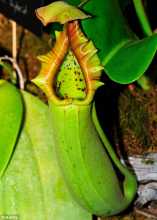Sadly, thought to already be extinct in the wild
Some time in the 1980s, botanist and adventurer Rob Cantley discovered the "Queen of Hearts" pitcher plant in Borneo. Although most pitcher plants are content to trap and devour small insects like ants and flies, the Queen of Hearts has pitchers which can be over eight feet long. Long enough to ensnare and slowly devour larger mammals, including mice and rats.
Pitcher plants trap their victims using modified leaves or flowers. These are curled into a tube and set upright, then filled with a sweet combination of nectar and trapped rainwater. Many pitcher plants also feature backwards-pointing hairs, which make it easy for their prey to slip into the jug - and difficult for them to climb out. The inside of the jug is slippery and curved in order to make escape impossible.
The fluid inside the Queen of Hearts pitcher plant is not only rainwater and sweet nectar. It also contains hydrochloric acid and enzymes, just like our own stomachs do. The trapped animals drown in the fluid and settle to the bottom of the jug, where the plant is able to dissolve their remains and extract the nutrients.
Five years ago, this amazing species of carnivorous pitcher plant stole the spotlight at the Chelsea Flower Show. Its growers won a staggering four gold medals from the Royal Horticultural Society, and caused a sensation in the world of botanists and carnivorous plant enthusiasts.
After this year's show, someone showed photographs of the plant to Dr. Martin Cheek of the Royal Botanic Gardens in England. He immediately identified it as a new species, a recognition which has formalized the plant's new scientific name: Nepenthes robcantlieyi (after the botanist who originally discovered it).
Unfortunately, the territory where Cantley collected his specimen has since experienced terrible deforestation due to logging (most of it illegal), and forest fires. The fires are set by locals to clear the land in order to plant it - often for palm kernel oil plantations - but then rage out of control and devastate the local ecology. The Queen of Hearts is likely extinct in the wild, or very nearly so.
The Queen of Hearts has followed a backwards path to fame. Most plants are collected, described scientifically, and only then brought to the public's attention due to cultivation by fanciers and gold medals won at garden shows. But it's a good thing it followed its odd path, because given the situation with the Borneo rainforests, otherwise it might have been lost to the world before it was even discovered.
